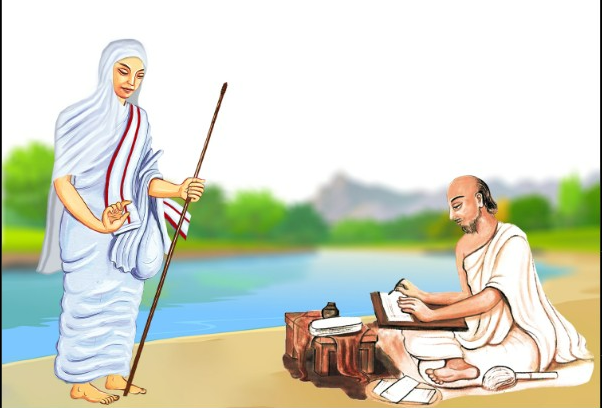Women Intellectuals and Authors of Ancient & Medieval India - VI
Total Views |
Jain, Bouddha and Tantra Sadhana Gurus
In the first ten centuries of CE, many philosophies, religious practices, and meditation methods were peacefully developed in India. Jain religion and philosophy were developed, and their influence grew in this period. Women scholars made significant contributions to the process. Among them, Yakini Mahattara deserves special notice. Haribhadra-süri was a brahmin scholar, well versed in the shastras (scriptures), who declared that he would accept the person who defeated him in argument as a guru. A leader (Mahattara) of Jaina nuns, Yakini by name, defeated him and converted him to the Jaina faith. The greatness of Yakini can be understood if only one realizes the contribution of the versatile scholar Haribhadra-süri to Jain literature and the reform initiated by him in the Jaina sect. Haribhadra wrote on ethics, yoga, logic and rituals, also wrote commentaries on older texts, composed story works and reformed the Jaina school of thought by vehemently opposing the monks who adopted chaitya-vasa (residence in shrines) or kept money, etc. It was not an easy task to defeat such a dialectician in argument and convert him to such an extent that he should take special pride in calling himself Yakini-Mabattara-sünu (son of the great Jaina nun Yakini)!
Yakini Mahattara
It was not uncommon to find nuns of high calibre and great learning among the Jainas. Guna Sadhwi, for instance, who prepared the first copy of that monumental allegorical work of Siddharshi, the Upamitabhava-prapaticha-katha, in 905 CE, is addressed by Siddharshi himself as the goddess of learning incarnate! In 1118 CE, in the age of Siddharaja Jayasinha, two nuns, Mahanandashri Mahattara and Ganini Viramati, actively helped Hemachandra in the composition of a lengthy commentary on the Visheshavashyaka-bhashya of Jinabhadra. In 1350 A.D, Gunasamriddhi Mahattara composed a Prakrit work entitled the Anjana-sundari-charitra.
The Bouddha tradition of women Gurus seems to have continued at least till 10th Century. Various inscription at Sanchi, Mathura, Amravati in Andhra Pradesh and at other places suggest a continuous tradition of woman nuns who were nuns having their own disciples.Yasila, Gada, Mitasiri, Dinna, Pusahatini, Reti, Padumantika, Samudiya, emerge as influential Nuns from these inscriptions. Most genealogies and lineages are patrilines, so to note oneself in relation just to another woman is significant, and, in and of itself, demonstrates something of the importance of these female teachers. The period of these inscriptions is from 2 century BCE to almost 6th century CE. If these Nuns have produced any literature it has not survived the onslaught of Islamic invasions. But a corpus of texts by women authors of around 10th Century from a remote place did survive.
The Swat valley Tantra Sadhana literature
The Swat valley, a narrow canyon encircled by high mountains of the Hindu Kush range, is currently in the Khyber Paktunkhwa Province of Pakistan. Numerous archaeological sites attest to the valley’s ancient heritage. The Muslim Pakhtuns who dominate today are, in fact, migrants from Afghanistan, who gradually colonized the valley starting with a smaller influx in the early eleventh century and a bigger wave of settlers who arrived in the late fifteenth century. The arrival of the Pakhtuns ultimately altered the fate of Swat’s earlier inhabitants, the Dards. Forced displacement and religious conversion rendered them a dispossessed minority. Similar fate awaited the Kalash people of nearby Chitral valley. But up-to 10th century CE, this entire region had a strong Hindu-Bouddha presence. In fact, It was an important center of Tantra Sadhana tradition and was called the 'Uddiyan Peeth'.
From 6th century CE onward we see the emergence of Tantra Sadhana, a synthesis of the Bouddha meditation and traditional yoga techniques. As Tantra Sadana was very much influential in Tibet, many books of Tantra were translated into Tibetan language and were preserved in Buddhist monasteries in Tibet, sometimes along with original Sanskrit manuscripts. From this corpus, researchers have found out that till now 11 texts written by 7 women Yoginis in the period range of eighth to the eleventh centuries CE. Lalita Devi, Sahajavajra, Vajravati Brahmani, Laksmi, the sisters Mekhala and Kanakhala, and Dakini Siddharajani. They are from divergent segments of society indicating the deep spread of Tantra.
Lalita Devi: The earliest known female guru from Swat was a local princess. Having received the meditation technique called 'sahaja' from her Guru rishi Jagadashavasa, she took up the life of a wandering ascetic, a yoginī. Although she is not known to have composed any written works, It was her student lineage, 'Shishya parampara' which produced further female Yoginis.
Lalita Devi was a princess. Sahajavajra was a liquor seller who grew tired of always drinking and then sought to learn meditation. Padmavajra, her Guru knew through his yogic powers Sahajavajra's potential. He therefore came to her bar and imparted his teaching to her. Subsequently, she became a well-known female guru in Uddiyana. Sahajvajra's composition Vyaktabhavanugata Tattvasiddhi, meaning “Accomplishment in the Reality Underlying Manifest Things”, achieved such importance that it later was included in some of the most significant Indian Tantric commentaries, as well as in a cycle of Tibetan translations known as 'Ashta Siddhi', “The Eight Siddhi Texts”. Her work also includes a catalog of common religious disciplines in Uḍḍiyāna, ranging from the shamanistic to the ascetic to the yogic. The text is extant in several Sanskrit manuscripts and a Tibetan translation produced in the mid-eleventh century.
Vajravati Brahmani composed a sadhana of Pitheshwari (red, wrathful form of the goddess Tara) A significant aspect of this ritual is the visualization of a mandala of 24 female yogini goddesses in 24 points inside the practitioner’s own body, which represents an internalization of the 24 external sites of Tantric pilgrimage, including the seat (Pitha) of Uddiyana.
The spread of Tantra Sadhana was not limited to Swat valley. Two woman yogini authors are from Kashmir. Bhikshuni lakshmi has written a treatise on meditation technique involving God Avalokiteshwara. Niguma is another prolific author. Her eleven Tantra Sadhana texts are preserved in Tibetan translations.
Upasika Yashobhadra, Kambal matraka, sisters Mekhala and Kanakhala are women whose texts have been preserved in Tibetan monasteries but further information about them is not available in the texts.
The long tradition of women yoginis, the complex meditation techniques mentioned in all these books indicate that they were advanced practitioners of Tantra Sadhana, accomplished teachers and authors. It also indicates the equal status of men and women in Tantra Sadhana practice.



